It's about time for another update to this thread! I've dropped a few from the collection that didn't appeal to me as much as the others, and added a bunch more to make up for it. The new additions:
France 1791-I Ecu, PCGS AU58
A nice solid crown-sized piece with glossy surfaces and superb eye appeal:
Austria 1892 Medal, Hauser-1754, PCGS SP63
This piece has a great three-quarters bird's eye view of the factory it commemorates - a rare perspective to be found on coins or medals:
Germany 1910-E Mark, PCGS PR67DCAM
This is a "wow" coin in hand. Some of the deepest mirrors and greatest cameo contrast I've seen on a 100+ year old coin. Here's a nice video of it when it was raw: https://imgur.com/a/gXnAN9m
Japan 1914 Yen, PCGS MS63
I don't think I even have to comment anything about this one...
France 1918 Copper-Nickel 10 Centimes, PCGS MS67+
A lovely and inexpensive little piece. Don't often see toning like this on copper-nickel - reminds me of my Chilean 1933 Peso in that way (and the same grade, weirdly):
The Diocletian argenteus looks like a Sisak Hoard piece.
@lordmarcovan said:
PS- I think I recognize that 1805 Irish proof 1/2d from Atlas inventory. I came within a whisker of buying it.
Thank you! Good eye - the 1805 1/2d is ex-Atlas, although it was in a different holder at the time. The argenteus is indeed from the Sisak Hoard. After I bought it I took a look at Aleksander Jelocnika's "The Sisak Hoard of Argentei of the Early Tetrarchy" to see if I could find mine among the plates in the book, but it wasn't there (only a fraction of the pieces were photographed though). A lot of the pieces from that hoard seem to have developed very nice color. -Rex
Realized I'm a couple of months behind on updating this thread, so here's what's new:
France, Royal. Philippe III le Hardi (1270-1285) silver Gros Tournois à la O rond (Touraine region, with round "O"), PCGS MS63. The obverse of this piece contains a border of twelve fleurs-de-lis around a central "Châtel Tournois", with the text "TVRONVS▾CIVIS", and the reverse a short cross pattée with the surrounding text of "BNDICTV⁝SIT⁝NOmE⁝DNI⁝ȠRI⁝DЄI⁝IhV.XPI" and "PhlLIPPVS▾REX". Duplessy-213c; Van Hengel-333.01; Lafaurie-217; Ciani-203. 24.5mm, 4.11 g, 7h.
The Gros Tournois, with a value of twelve silver pennies, was the first multiple of the penny to be issued north of the Alps. First struck under the reign of Louis IX in 1266, its success encouraged other mints to strike similar coins and played an important role in economic development in the region. Although the predominance of silver was relatively short lived, being replaced in the fourteenth century by gold, nonetheless the gros tournois enjoyed a curious posthumous circulation. The last main French regal issue was struck in 1307, but the gros tournois continued to circulate, both in the form of originals and signed and unsigned imitations, for another century east of the Rhine and further North.
During the reign of Philip III "the Bold" from 1270-85, the French monarchy was enlarged and the royal domain extended, mainly through his annexation of Poitiers and Toulouse. The King's foreign policy and military ventures, however, were largely unsuccessful. In 1276 he declared war to support the claims of his nephews as heirs in Castile, but soon abandoned the venture. In 1284, at the instigation of Pope Martin IV, he launched a campaign against Peter III of Aragon, as part of the War of the Sicilian Vespers, in which the Aragonese opposed the Angevin rulers of Sicily. Philip crossed the Pyrenees with his army in May 1285, but the atrocities perpetrated by his forces provoked a guerrilla uprising. After a meaningless victory at Gerona and the destruction of his fleet at Las Hormigas, Philip was forced to retreat. He died of fever during his return home.
There is some possibility that this particular example was struck during the reign of the Philippe IV, le Bel ("the Fair) circa the years 1285-1290. Unfortunately it would appear that both Philip III and Philip IV used the word "PhILIPPVS" on their coinage, without any further indication of the distinctive ruler. Using clues such as the stylization of the individual lettering on the coins, the symbols used for punctuation, and the known dates of buried hoards that have been found, some of the many varieties of gros tournois can be attributed with reasonable confidence to one ruler or the other, and to certain date ranges. It is known, for example, that around 1290, during the reign of Philip IV, there was a switch from a round, circular "O" in TVRONVS (gros tournois à l'O rond) to an ovular "O" (gros tournois à l'O long). Coinage is known to have continued until 1295 and then ceased until 1305 during a period of "weak money". From 1305-1307, mintage of the gros tournois was revived. It is unclear exactly what styles of gros were struck during this latter era, but it seems possible that both round O and long O types were issued. However, I have shown this piece to one of the current experts on the coinage, Marcus Philipps of The Royal Numismatic Society, and he seems to lean toward it being of the 1270-1285 type struck under Philip III, or the 1285-1290 type struck under Philip IV. In his words, "This is one of the groups which could be either Philip III or IV. In my review of the Bonn (Boeselager) hoard I have put it under Philip III but one cannot be sure. It is all very subjective and there are not any conclusive hoards of the right date. The lettering on yours is rather ornate but not irregular. The open C in CIVIS looks early."
Italian States, Sicily. Frederick III ("IV"), the Simple (Federico il Semplice) silver Pierreale, struck at the Messina mint during his reign from 1355-1377. PCGS MS65.
Obverse: Crowned eagle with head turned to right, within tressure of eight arcs, ·FRIDERICUS:DEI:GRA:REX:SICILIE: around.
Reverse: Crowned shield of arms of Aragon divides R to left and G to right, AC:AThENAR:2:NEOPATRIE:DUX: around.
Frederick III was born in Catania, and in 1355 at the age of thirteen succeeded his brother Ludovico under the regency of his sister, Euphemia of Sicily. In his early years the realm was mainly under the control of powerful Sicilian barons, in particular Artale I Alagona, Count of Mistretta. The beginning of his reign was plagued by intermittent wars with the Kingdom of Naples (a continuation of the War of the Sicilian Vespers, referred to in the other post about the French Gros Tournois) and also by the Black Death, to which his elder brother and predecessor succumbed. His reign, though not uncommon as such, was marked by considerable antisemitism. On Oct. 12th, 1366, he prohibited the external decoration of synagogues; in consequence of this law all old synagogues that had already been decorated were pulled down. On Dec. 25th, 1369, he ordered all Jews to wear a badge indicating their heritage. The badge consisted of a piece of red material, not smaller than the largest royal seal; men were required to wear it under the chin, and women on the chest. In 1372 he was finally able to make peace with Naples and Pope Gregory XI, definitively concluding the war begun ninety years before with the revolt of the Vespers against the rule of the French-born King Charles I of Anjou.
German States, Bavaria, 1855 2 Gulden, PCGS MS64PL (Prooflike). Portrait of the King right / the Madonna Column. KM-848. On the restoration of the Madonna (Mary's) Column in Munich. Superbly toned and deeply prooflike; possibly a proof striking.
Austria 1881 silver Calendar Medal, PCGS MS62. By Leisek and Fromme. Conjoined busts of the married couple right / Calendar of Sundays. Wurzbach-8058; Hauser-381; Strothotte 1881-2. Struck for the occasion of the wedding of Rudolf of Austria with Stephanie of Belgium.
Comments
It's about time for another update to this thread! I've dropped a few from the collection that didn't appeal to me as much as the others, and added a bunch more to make up for it. The new additions:
Great Britain (England) Charles I 1628 Pattern Halfcrown, PCGS SP40

Discussion: https://forums.collectors.com/discussion/1018175/1628-pattern-halfcrown#latest
France 1791-I Ecu, PCGS AU58

A nice solid crown-sized piece with glossy surfaces and superb eye appeal:
Austria 1892 Medal, Hauser-1754, PCGS SP63
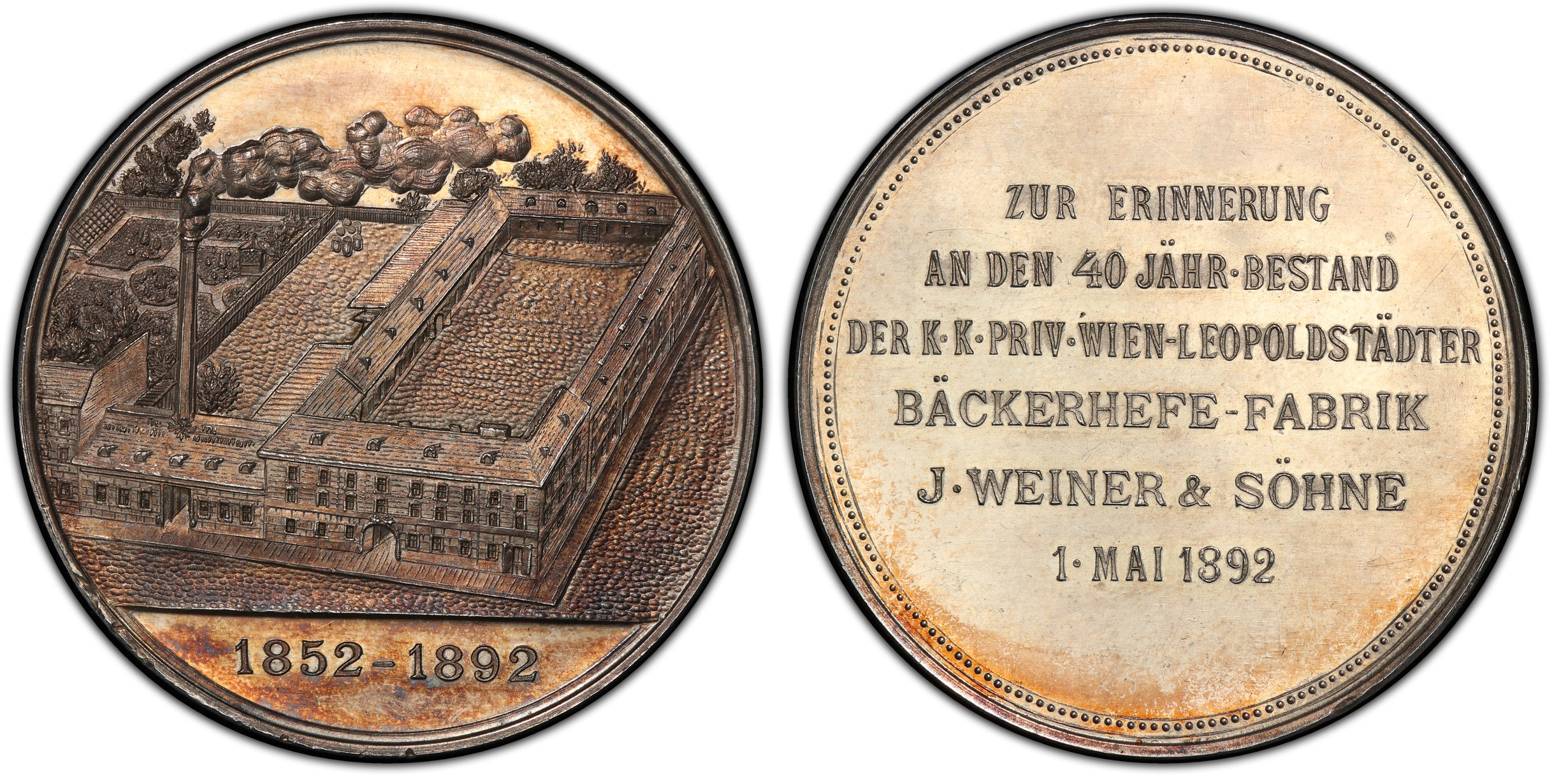
This piece has a great three-quarters bird's eye view of the factory it commemorates - a rare perspective to be found on coins or medals:
France 1900 Silver-Plated Bronze Medal, Maier-79, PCGS MS65
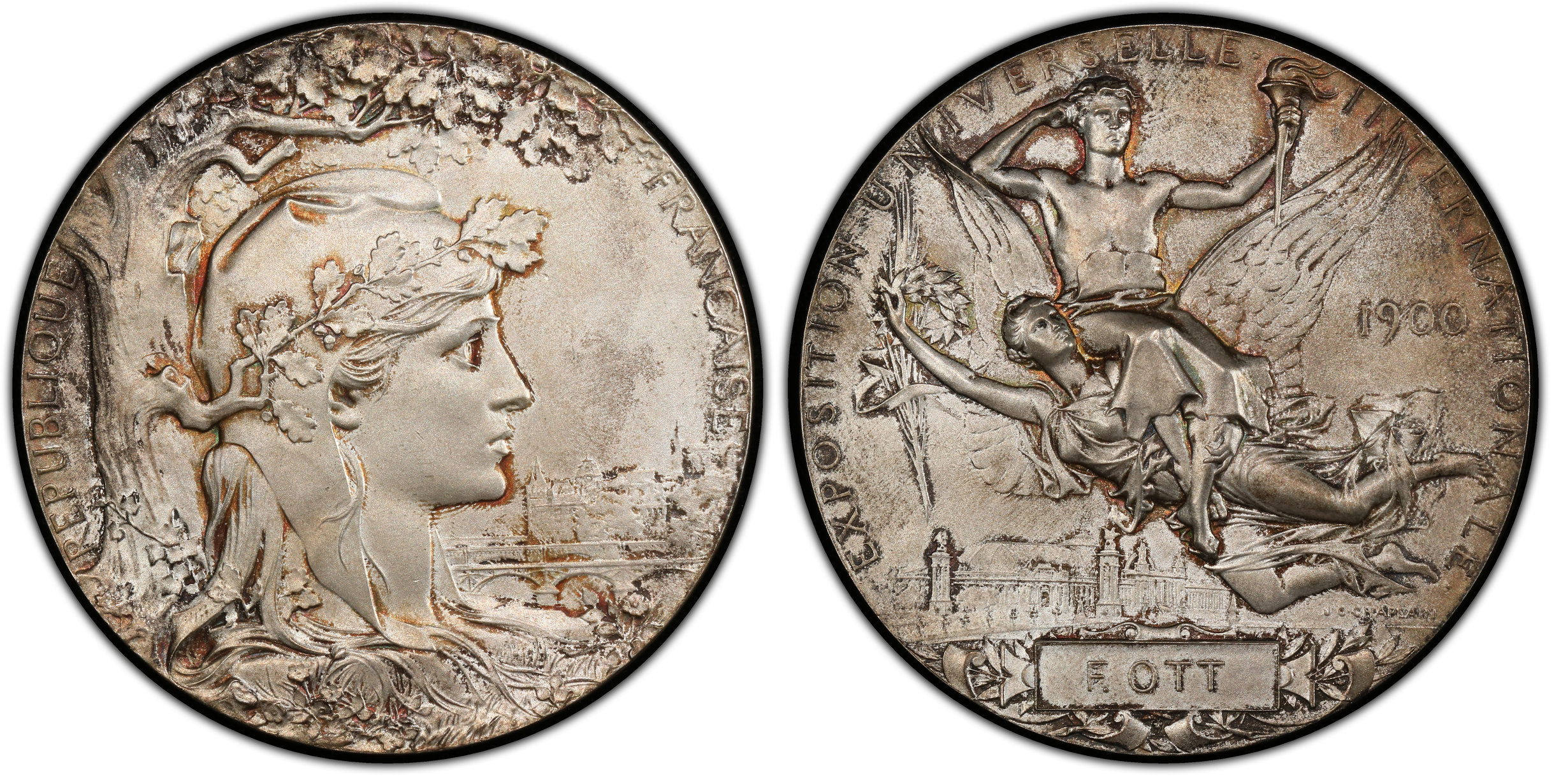
Discussion: https://forums.collectors.com/discussion/1019419/newp-french-turn-of-the-century-art-nouveau-medal#latest
Germany 1910-E Mark, PCGS PR67DCAM
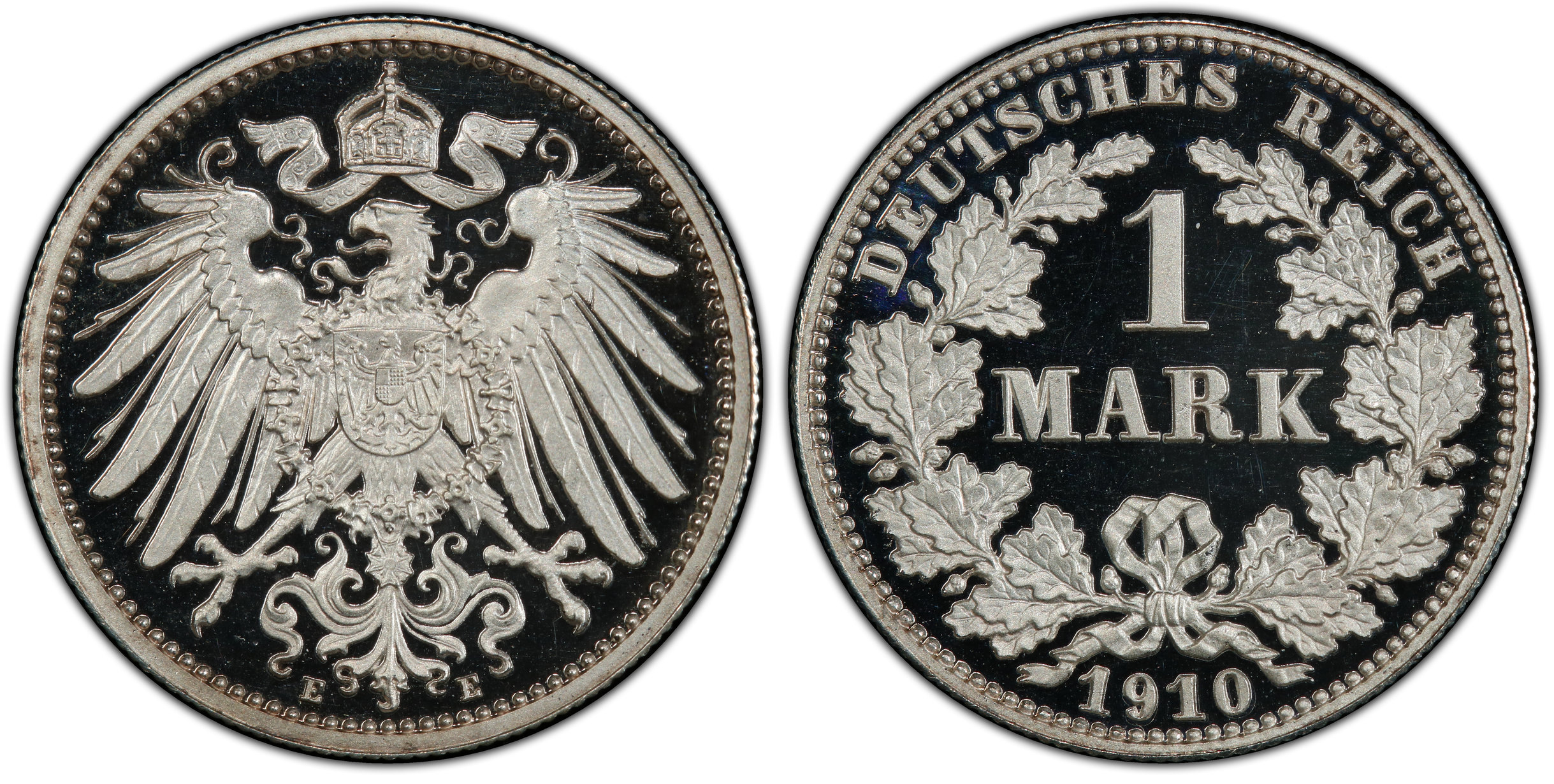
This is a "wow" coin in hand. Some of the deepest mirrors and greatest cameo contrast I've seen on a 100+ year old coin. Here's a nice video of it when it was raw: https://imgur.com/a/gXnAN9m
Japan 1914 Yen, PCGS MS63

I don't think I even have to comment anything about this one...
Germany 1915 Lusitania Medal, Kienast-156 ("7. MAI" Type), ORIGINAL in cast bronze, PCGS MS64

Discussion: https://forums.collectors.com/discussion/1019418/newp-rare-original-cast-bronze-lusitania-medal-pcgs-ms64#latest
France 1918 Copper-Nickel 10 Centimes, PCGS MS67+
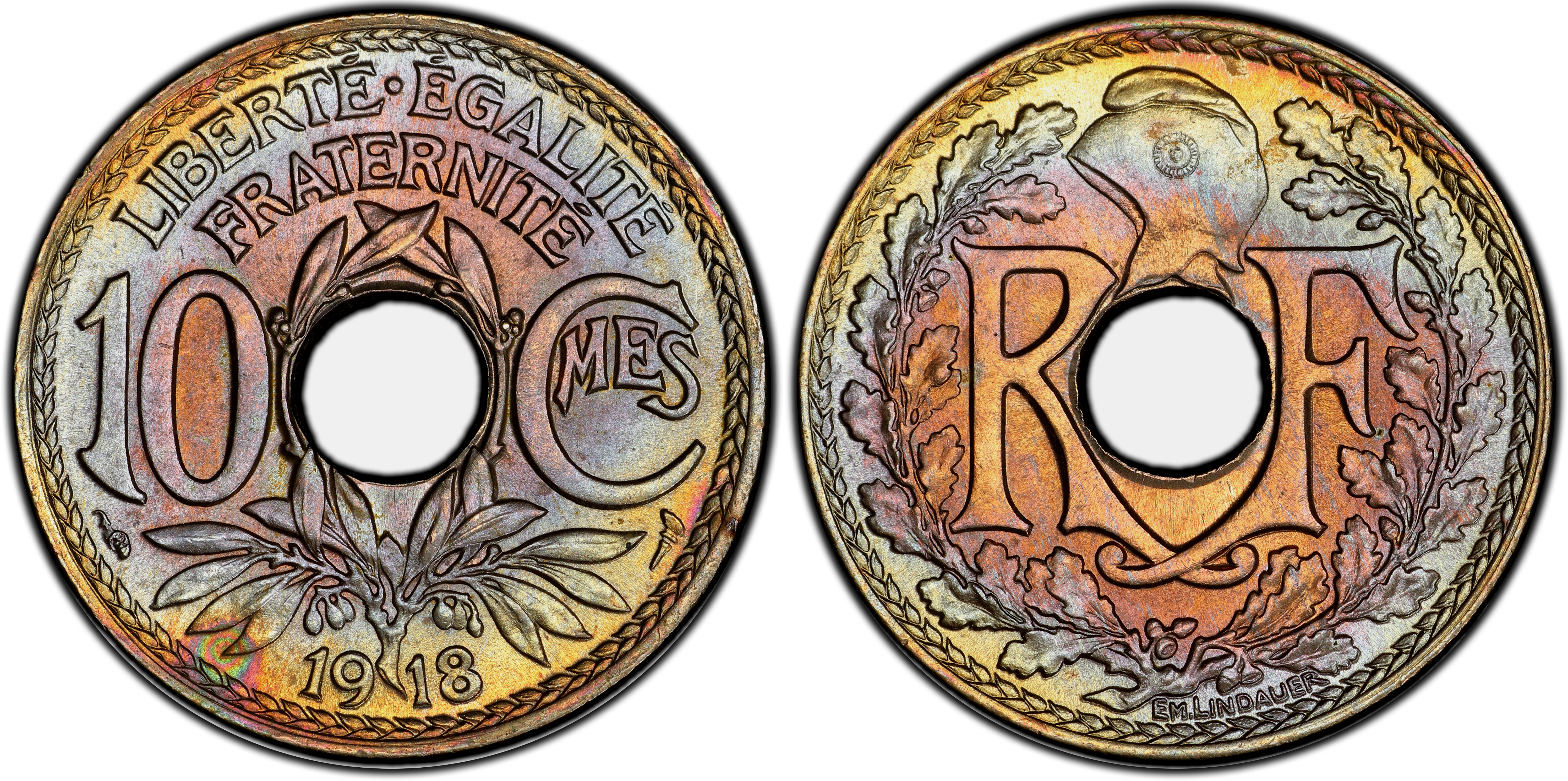
A lovely and inexpensive little piece. Don't often see toning like this on copper-nickel - reminds me of my Chilean 1933 Peso in that way (and the same grade, weirdly):
Gobrecht's Engraved Mature Head Large Cent Model
https://www.instagram.com/rexrarities/?hl=en
Amazing additions!
Look at those designs!
The details that went into them is awesome!
Thanks for showing your combined update @Rexford.
It is ALL amazing.
The Diocletian argenteus looks like a Sisak Hoard piece.
Collector since 1976. On the CU forums here since 2001.
PS- I think I recognize that 1805 Irish proof 1/2d from Atlas inventory. I came within a whisker of buying it.
Collector since 1976. On the CU forums here since 2001.
Thank you! Good eye - the 1805 1/2d is ex-Atlas, although it was in a different holder at the time. The argenteus is indeed from the Sisak Hoard. After I bought it I took a look at Aleksander Jelocnika's "The Sisak Hoard of Argentei of the Early Tetrarchy" to see if I could find mine among the plates in the book, but it wasn't there (only a fraction of the pieces were photographed though). A lot of the pieces from that hoard seem to have developed very nice color. -Rex
Gobrecht's Engraved Mature Head Large Cent Model
https://www.instagram.com/rexrarities/?hl=en
Realized I'm a couple of months behind on updating this thread, so here's what's new:
France, Royal. Philippe III le Hardi (1270-1285) silver Gros Tournois à la O rond (Touraine region, with round "O"), PCGS MS63. The obverse of this piece contains a border of twelve fleurs-de-lis around a central "Châtel Tournois", with the text "TVRONVS▾CIVIS", and the reverse a short cross pattée with the surrounding text of "BNDICTV⁝SIT⁝NOmE⁝DNI⁝ȠRI⁝DЄI⁝IhV.XPI" and "PhlLIPPVS▾REX". Duplessy-213c; Van Hengel-333.01; Lafaurie-217; Ciani-203. 24.5mm, 4.11 g, 7h.
The Gros Tournois, with a value of twelve silver pennies, was the first multiple of the penny to be issued north of the Alps. First struck under the reign of Louis IX in 1266, its success encouraged other mints to strike similar coins and played an important role in economic development in the region. Although the predominance of silver was relatively short lived, being replaced in the fourteenth century by gold, nonetheless the gros tournois enjoyed a curious posthumous circulation. The last main French regal issue was struck in 1307, but the gros tournois continued to circulate, both in the form of originals and signed and unsigned imitations, for another century east of the Rhine and further North.
During the reign of Philip III "the Bold" from 1270-85, the French monarchy was enlarged and the royal domain extended, mainly through his annexation of Poitiers and Toulouse. The King's foreign policy and military ventures, however, were largely unsuccessful. In 1276 he declared war to support the claims of his nephews as heirs in Castile, but soon abandoned the venture. In 1284, at the instigation of Pope Martin IV, he launched a campaign against Peter III of Aragon, as part of the War of the Sicilian Vespers, in which the Aragonese opposed the Angevin rulers of Sicily. Philip crossed the Pyrenees with his army in May 1285, but the atrocities perpetrated by his forces provoked a guerrilla uprising. After a meaningless victory at Gerona and the destruction of his fleet at Las Hormigas, Philip was forced to retreat. He died of fever during his return home.
There is some possibility that this particular example was struck during the reign of the Philippe IV, le Bel ("the Fair) circa the years 1285-1290. Unfortunately it would appear that both Philip III and Philip IV used the word "PhILIPPVS" on their coinage, without any further indication of the distinctive ruler. Using clues such as the stylization of the individual lettering on the coins, the symbols used for punctuation, and the known dates of buried hoards that have been found, some of the many varieties of gros tournois can be attributed with reasonable confidence to one ruler or the other, and to certain date ranges. It is known, for example, that around 1290, during the reign of Philip IV, there was a switch from a round, circular "O" in TVRONVS (gros tournois à l'O rond) to an ovular "O" (gros tournois à l'O long). Coinage is known to have continued until 1295 and then ceased until 1305 during a period of "weak money". From 1305-1307, mintage of the gros tournois was revived. It is unclear exactly what styles of gros were struck during this latter era, but it seems possible that both round O and long O types were issued. However, I have shown this piece to one of the current experts on the coinage, Marcus Philipps of The Royal Numismatic Society, and he seems to lean toward it being of the 1270-1285 type struck under Philip III, or the 1285-1290 type struck under Philip IV. In his words, "This is one of the groups which could be either Philip III or IV. In my review of the Bonn (Boeselager) hoard I have put it under Philip III but one cannot be sure. It is all very subjective and there are not any conclusive hoards of the right date. The lettering on yours is rather ornate but not irregular. The open C in CIVIS looks early."
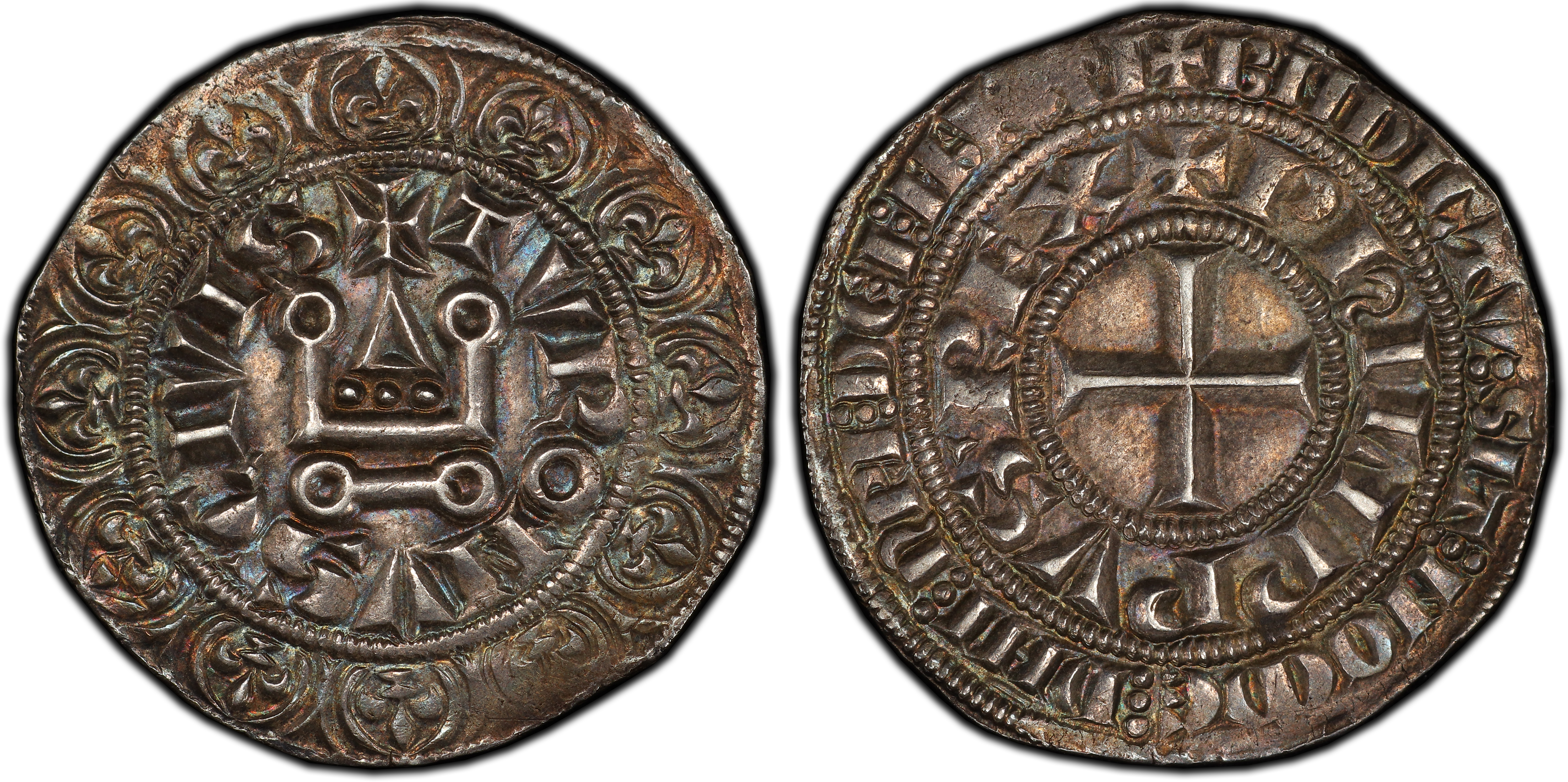
Italian States, Sicily. Frederick III ("IV"), the Simple (Federico il Semplice) silver Pierreale, struck at the Messina mint during his reign from 1355-1377. PCGS MS65.
Obverse: Crowned eagle with head turned to right, within tressure of eight arcs, ·FRIDERICUS:DEI:GRA:REX:SICILIE: around.
Reverse: Crowned shield of arms of Aragon divides R to left and G to right, AC:AThENAR:2:NEOPATRIE:DUX: around.
Frederick III was born in Catania, and in 1355 at the age of thirteen succeeded his brother Ludovico under the regency of his sister, Euphemia of Sicily. In his early years the realm was mainly under the control of powerful Sicilian barons, in particular Artale I Alagona, Count of Mistretta. The beginning of his reign was plagued by intermittent wars with the Kingdom of Naples (a continuation of the War of the Sicilian Vespers, referred to in the other post about the French Gros Tournois) and also by the Black Death, to which his elder brother and predecessor succumbed. His reign, though not uncommon as such, was marked by considerable antisemitism. On Oct. 12th, 1366, he prohibited the external decoration of synagogues; in consequence of this law all old synagogues that had already been decorated were pulled down. On Dec. 25th, 1369, he ordered all Jews to wear a badge indicating their heritage. The badge consisted of a piece of red material, not smaller than the largest royal seal; men were required to wear it under the chin, and women on the chest. In 1372 he was finally able to make peace with Naples and Pope Gregory XI, definitively concluding the war begun ninety years before with the revolt of the Vespers against the rule of the French-born King Charles I of Anjou.

German States, Bavaria, 1855 2 Gulden, PCGS MS64PL (Prooflike). Portrait of the King right / the Madonna Column. KM-848. On the restoration of the Madonna (Mary's) Column in Munich. Superbly toned and deeply prooflike; possibly a proof striking.

Austria 1881 silver Calendar Medal, PCGS MS62. By Leisek and Fromme. Conjoined busts of the married couple right / Calendar of Sundays. Wurzbach-8058; Hauser-381; Strothotte 1881-2. Struck for the occasion of the wedding of Rudolf of Austria with Stephanie of Belgium.

Gobrecht's Engraved Mature Head Large Cent Model
https://www.instagram.com/rexrarities/?hl=en
Great stuff! Great write up!
My current "Box of 20"
Thanks! And thanks for letting me take that Gros off your hands 😁
Gobrecht's Engraved Mature Head Large Cent Model
https://www.instagram.com/rexrarities/?hl=en